
Few early birds caught for good reason
4/24/2005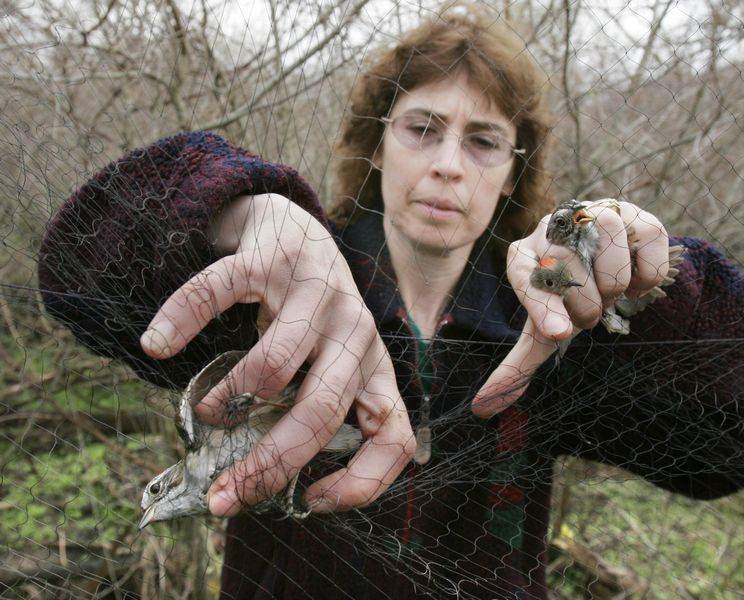
Julie Shieldcastle removes a swamp sparrow. By the end of the migration season, 8,000 to 10,000 birds will be banded.
The early bird-catchers are catching the - no, not worms - the early birds.
Which is as it should be, here on the eve of six weeks of the sometimes frenetic spring migrations by neotropical songbirds.
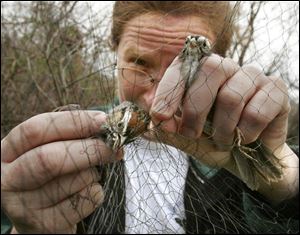
Linda Bode removes swamp sparrows from a net at the Black Swamp Bird Observatory banding project site near the Davis-Besse Nuclear Power Station.
The bird-catchers, to define a casual term, are the volunteers and staff of the Oak Harbor-based Black Swamp Bird Observatory, which maintains a banding station along the western Lake Erie shoreline.
The station lies within the restricted confines of the federal Navarre Marsh, just west of Davis-Besse Nuclear Power Station, and last weekend the BSBO crew began the annual springtime project of attaching tiny numerical metal bands to the legs of birds.
The volunteers erected strings of mist nets - something like fine, soft volleyball nets - and started capturing the first of the spring's migrants - white-throated sparrows, yellow-rumped (myrtle) warblers, and a smattering of others, the numbers of which are expected to grow substantially in the coming days.
By the end of the migration season in early June, BSBO staff will have banded 8,000 to 10,000 songbirds among a long list of species. Note that snaring these little birds, handling them, banding them, and releasing them basically is harmless. The benefits, however, are worth the effort.
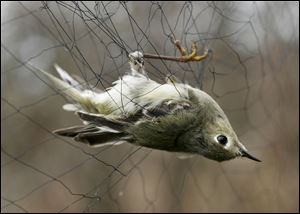
A white-throated sparrow, which is alive, waits in the net for its turn to be removed and banded at Navarre Marsh.
"The actual act of banding simply is to create a marked population," explained Mark Shieldcastle, research director for BSBO and a professional biologist for the Ohio Division of Wildlife. "There are many reasons for doing the banding, depending on the research goals."
Ornithologists, for example, may be studying the death rates or survival rates for species known to be threatened or in decline. They may want migrational data - when do various species migrate, and where from and where to.
Or, the concern may be global. That is, a species may winter in tropical rain forests in Central America or South America and nest in the summer in the boreal forests of Canada - and stop on the western Lake Erie shoreline in between.
Each time a banded bird is recaptured, or even found deceased, a record of its place and time is recorded. Records are posted and shared, thus helping create a picture of the bird's annual, or perhaps lifetime, travels. Such details can be critical to understanding a species' needs for nesting and resting and wintering habitat. In turn such information may point out habitat conservation needs.
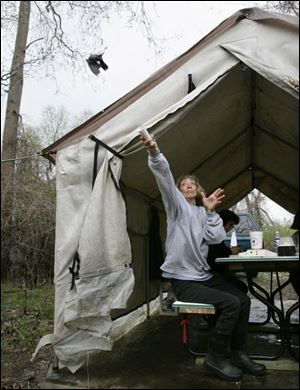
Jan Dixon releases a red-winged blackbird after it was banded. The banding procedure does not harm the fragile birds.
The lakeshore's marshes, wooded sand ridges, and beaches are a critical resting zone for up to 250 species of songbirds each spring. Some species will stop, refuel on a smorgasbord of insects, and take off nonstop across the lake. Others, intimidated by such an overflight, will skirt the lakeshore and then swing north.
As of Friday, other species of early songbirds to put in first appearances in BSBO nets were red-winged black birds, ruby-crowned kinglets, a handful of blue-gray gnatcatchers, and a few different wood warblers such as black-throated green, western palm, prothonotary, pine, worm-eating, hooded, and black and white. The latter is the mascot species of BSBO.
During a typical migration season, possibly 35 species of wood warblers, which are supremely popular among birders, will pass through the region. The mix may include the Kirtland's warbler, the rarest wood warbler in the world with just 1,300 or so pairs. The Kirtland's principally trades between the Bahamas and northeast lower Michigan's jack pine forests.

Julie Shieldcastle removes a swamp sparrow. By the end of the migration season, 8,000 to 10,000 birds will be banded.
An array of shorebirds and waterbirds also is starting to arrive, according to Mary Warren, a naturalist at Magee Marsh State Wildlife Area, which lies along the lakeshore in western Ottawa County off State Rt. 2. Her list so far includes such shorebirds as dunlin and greater and lesser yellowlegs, plus such wading birds as little blue heron and snowy egret.
The shorebirds and waders, Warren added, can be seen along the Magee access road that leads to the lake and Crane Creek State Park, the latter a tiny beachfront picnic site. Magee also is home to the Magee Marsh Bird Trail, a lakeshore boardwalk site renowned among birders.
Most of these species so far have just come in as individuals, said Warren. "It really hasn't been a wave."
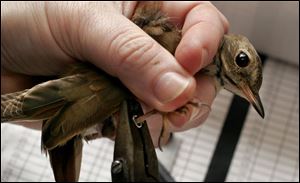
Linda Bode bands a hermit thrush at the Black Swamp Bird Observatory project site at Navarre Marsh near the Davis-Besse Nuclear Power Station grounds. The songbird migration will be rather sparse this weekend because of the cold weather. The last wave of the birds will occur about the last week of May, peaking around Memorial Day.
Speaking of which, BSBO over the years has documented what are believed to be three distinct waves of neotropical songbird migration each spring.
Julie Shieldcastle, BSBO executive director and Mark's spouse, said that the first wave or mass influx of migrants typically occurs between April 25 and 30. But don't look for it this week, at least until the prevailing, unseasonal wintry mix disappears and the weather moderates considerably.
It takes warm temperatures and strong southwest winds to bring up the feathered hordes. The first migrational wave is known for "overflight species," that is, ones that have come too far north and end up turning back a way in "reverse migration" before settling into nest.
The second wave generally occurs during the first two weeks of May and usually contains the greatest diversity of species. It peaks around Mother's Day. The third wave usually occurs the last week of May, peaking around Memorial Day, and usually includes the largest volume of birds if not the greatest diversity.
Amid the waves of birds , a few of them- a few thousand, that is - unknowingly and inadvertently will contribute to ornithological research and possibly their own long-term conservation by taking a brief detour into caring human hands, thanks to the mist nets set by BSBO.
Contact Steve Pollick at: spollick@theblade.com or 419-724-6068.